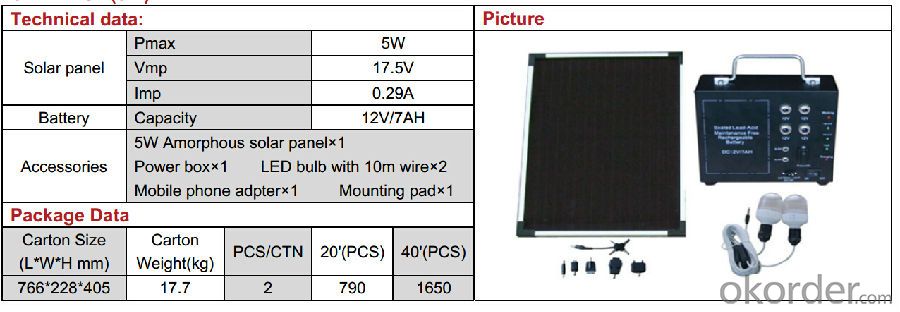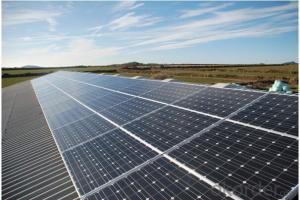solar system 5w which made in China
- Loading Port:
- China Main Port
- Payment Terms:
- TT OR LC
- Min Order Qty:
- -
- Supply Capability:
- -
OKorder Service Pledge
Quality Product, Order Online Tracking, Timely Delivery
OKorder Financial Service
Credit Rating, Credit Services, Credit Purchasing
You Might Also Like

- Q:Can solar energy systems be installed on religious institutions?
- Yes, solar energy systems can be installed on religious institutions. Many religious institutions have recognized the importance of embracing sustainable practices and reducing their carbon footprint. Installing solar panels on their rooftops or grounds allows them to generate clean and renewable energy, which aligns with their values of stewardship and care for the environment. Additionally, solar energy systems can also help religious institutions save money on their electricity bills, freeing up resources to support their missions and community initiatives.
- Q:Do solar energy systems require grounding?
- Grounding is crucial for solar energy systems, as well as any other electrical system, for safety reasons. It serves as a protection against electrical faults, lightning strikes, and other potential dangers. In a solar energy system, grounding is typically accomplished by connecting all metal components, such as solar panels, inverters, and racking systems, to a common ground. This is done by using grounding wires or cables that are linked to a grounding electrode, like a grounding rod or a metal water pipe. Grounding plays various important roles in solar energy systems. Firstly, it safeguards against electrical shock hazards by providing a safe pathway for electrical currents in case of a fault or malfunction. Additionally, grounding helps prevent damage to the system by diverting lightning strikes or other electrical surges away from sensitive components. Moreover, grounding is mandatory according to electrical codes and regulations. These codes ensure the safe installation and operation of solar energy systems, adhering to industry standards. Failure to comply with grounding requirements can lead to safety risks, equipment harm, or even legal consequences. In conclusion, grounding is an essential and significant aspect of solar energy systems. It guarantees the system's and its operators' safety, shields against electrical faults and lightning strikes, and ensures adherence to electrical codes and regulations.
- Q:Can solar energy systems be used in areas with limited access to solar energy equipment suppliers?
- Yes, solar energy systems can still be used in areas with limited access to solar energy equipment suppliers. While it may be more challenging to obtain the necessary equipment, it is still possible to install and maintain solar energy systems in such areas. Additionally, advancements in technology and the availability of online marketplaces make it easier for remote areas to access solar energy equipment. Moreover, local communities can also explore partnerships or collaborations with nearby regions or organizations to ensure a sustainable supply of solar energy equipment in the long run.
- Q:What is the impact of hail on the performance of solar panels?
- Hail has the potential to cause significant damage to the performance of solar panels. The impact of hail on solar panels can vary depending on the size and velocity of the hailstones, as well as the quality and durability of the panels themselves. One immediate impact of hail is physical damage to the surface of the solar panels. Hailstones can create cracks or fractures in the glass or other protective layers of the panels, which can compromise their ability to capture sunlight and generate electricity. These damages can also lead to water infiltration, further reducing the efficiency and lifespan of the panels. Another consequence of hail is the displacement or misalignment of solar cells within the panels. If hailstones strike the panels with enough force, they can dislodge or shift the position of the cells, disrupting their optimal alignment and reducing the overall efficiency of the panel. This misalignment can result in decreased energy production and a decline in the panel's performance. Furthermore, hail can cause damage to the electrical connections and wiring within the solar panel system. Hailstones can impact the junction boxes, connectors, and cables, potentially causing them to loosen or break. This damage can lead to electrical faults, reduced energy output, and even system failure if not addressed promptly. In areas prone to hailstorms, it is crucial to consider the design and installation of solar panels to mitigate potential damage. Many manufacturers offer panels with tempered or reinforced glass to withstand the impact of hailstones better. Additionally, incorporating protective measures such as hail guards or covers can help shield the panels from direct hail damage. Regular maintenance and inspection are also essential to identify and address any hail-related damages promptly. Timely repairs or replacements of damaged panels, cells, or electrical components will help restore the performance and efficiency of the solar panel system. Overall, the impact of hail on the performance of solar panels can be significant, potentially reducing energy production and increasing maintenance costs. However, with proper precautions, durable materials, and adequate maintenance, the potential negative impact of hail on solar panels can be minimized, ensuring the longevity and effectiveness of the solar energy system.
- Q:Can solar energy systems be used in areas with limited space on rooftops due to existing equipment or structures?
- Yes, solar energy systems can be used in areas with limited space on rooftops due to existing equipment or structures. There are various types of solar energy systems available, such as solar panels that can be mounted on the ground or integrated into walls or facades. Additionally, innovative technologies like solar shingles or thin-film solar cells can be used in areas where traditional solar panels may not fit. Therefore, even with limited rooftop space, it is still possible to harness solar energy and benefit from its renewable and sustainable advantages.
- Q:What is net metering and how does it work?
- Net metering is a billing arrangement that allows solar panel owners to receive credit for excess electricity they generate and feed back into the grid. Essentially, it works by measuring the difference between the electricity a solar panel system produces and the electricity it consumes from the grid. If the solar system produces more electricity than it needs, the excess is sent back to the grid, and the owner gets credit for that electricity, which can be used to offset future consumption from the grid. This allows solar panel owners to save money on their electricity bills and encourages the adoption of renewable energy.
- Q:Can a solar energy system be used for heating and cooling?
- Yes, a solar energy system can be used for heating and cooling. Solar thermal systems can be used to provide heat by capturing and utilizing the sun's heat energy. These systems typically consist of solar collectors that absorb the sun's rays to heat a fluid, which is then used to heat water or air. The heated water can be used for various purposes, such as space heating, domestic hot water, or even for industrial processes. Additionally, solar energy can also be used for cooling through the use of solar-powered air conditioning systems. These systems utilize solar energy to power absorption chillers or heat-driven chillers, which cool the air by absorbing heat from it. This process is typically more energy-efficient than traditional air conditioning systems that rely on electricity. Furthermore, solar energy can also be harnessed for passive cooling. Passive solar cooling techniques involve designing buildings to maximize natural ventilation and shading, reducing the need for mechanical cooling systems. This can be achieved through techniques such as strategic building orientation, proper insulation, and the use of shading devices like awnings or overhangs. Overall, solar energy systems can indeed be used for both heating and cooling, offering sustainable and cost-effective solutions for meeting our thermal comfort needs.
- Q:Can solar energy systems be used in areas with strict building codes?
- Yes, solar energy systems can be used in areas with strict building codes. However, it may require complying with specific regulations and obtaining permits from the local authorities. The installation process may need to be adapted to meet the building code requirements while ensuring the safe and efficient functioning of the solar energy system.
- Q:Are solar energy systems expensive to install?
- Solar energy systems can be expensive to install initially, but they offer long-term benefits and savings on energy bills. The cost of installation depends on various factors such as the size of the system, location, and available incentives. However, with the decreasing cost of solar technology and potential for government incentives, the overall cost has become more affordable in recent years. Additionally, considering the long lifespan and the potential to sell excess energy back to the grid, solar energy systems can be a wise investment in the long run.
- Q:Can solar energy systems be used for powering electric plane systems?
- Solar energy systems have the ability to power electric plane systems. The concept of using solar power for aviation has gained considerable attention in recent years. In order to capture sunlight and convert it into electricity, solar panels can be installed on the wings and fuselage of an aircraft. This electricity can then be utilized to power various systems on the plane, including navigation, communication, lighting, and auxiliary power units. While it is currently not practical to solely rely on solar power for the main propulsion of a commercial plane due to the limited energy density of solar panels, solar energy can still play a valuable role in reducing overall energy consumption in aircraft. By utilizing solar power for auxiliary systems, electric planes can significantly decrease their dependence on traditional fossil fuel-based power sources. Experimental and small-scale projects have already shown promising results in solar-powered electric planes. For example, Solar Impulse 2, a solar-powered aircraft, successfully completed a round-the-world journey in 2016, highlighting the potential of solar energy in aviation. NASA is also actively exploring the application of solar energy in their electric aircraft research. However, there are still obstacles to overcome in order to fully integrate solar energy systems into commercial aviation. The efficiency and weight of solar panels need to be enhanced to generate sufficient power for larger aircraft. Additionally, advanced energy storage technologies must be developed to store excess solar energy for use during low-sunlight conditions or nighttime flights. Despite these challenges, the potential advantages of utilizing solar energy in aviation are significant. Solar-powered electric planes have the capability to reduce carbon emissions and decrease reliance on fossil fuels, ultimately leading to a more sustainable and environmentally friendly aviation industry. As technology continues to advance, the integration of solar energy systems into electric plane systems will likely become more feasible and widespread.
1. Manufacturer Overview |
|
|---|---|
| Location | |
| Year Established | |
| Annual Output Value | |
| Main Markets | |
| Company Certifications | |
2. Manufacturer Certificates |
|
|---|---|
| a) Certification Name | |
| Range | |
| Reference | |
| Validity Period | |
3. Manufacturer Capability |
|
|---|---|
| a)Trade Capacity | |
| Nearest Port | |
| Export Percentage | |
| No.of Employees in Trade Department | |
| Language Spoken: | |
| b)Factory Information | |
| Factory Size: | |
| No. of Production Lines | |
| Contract Manufacturing | |
| Product Price Range | |
Send your message to us
solar system 5w which made in China
- Loading Port:
- China Main Port
- Payment Terms:
- TT OR LC
- Min Order Qty:
- -
- Supply Capability:
- -
OKorder Service Pledge
Quality Product, Order Online Tracking, Timely Delivery
OKorder Financial Service
Credit Rating, Credit Services, Credit Purchasing
Similar products
New products
Hot products
Hot Searches
Related keywords



























